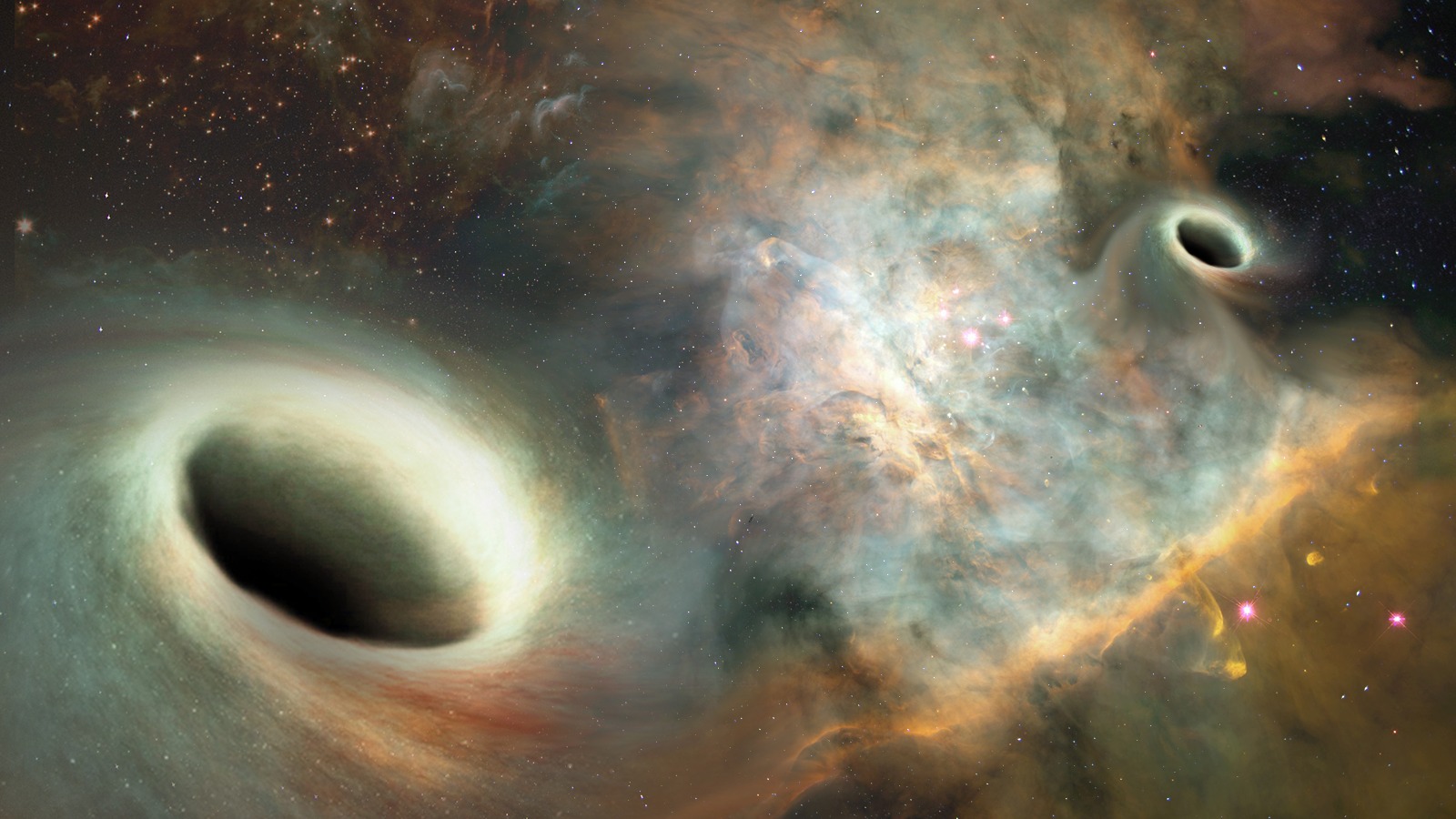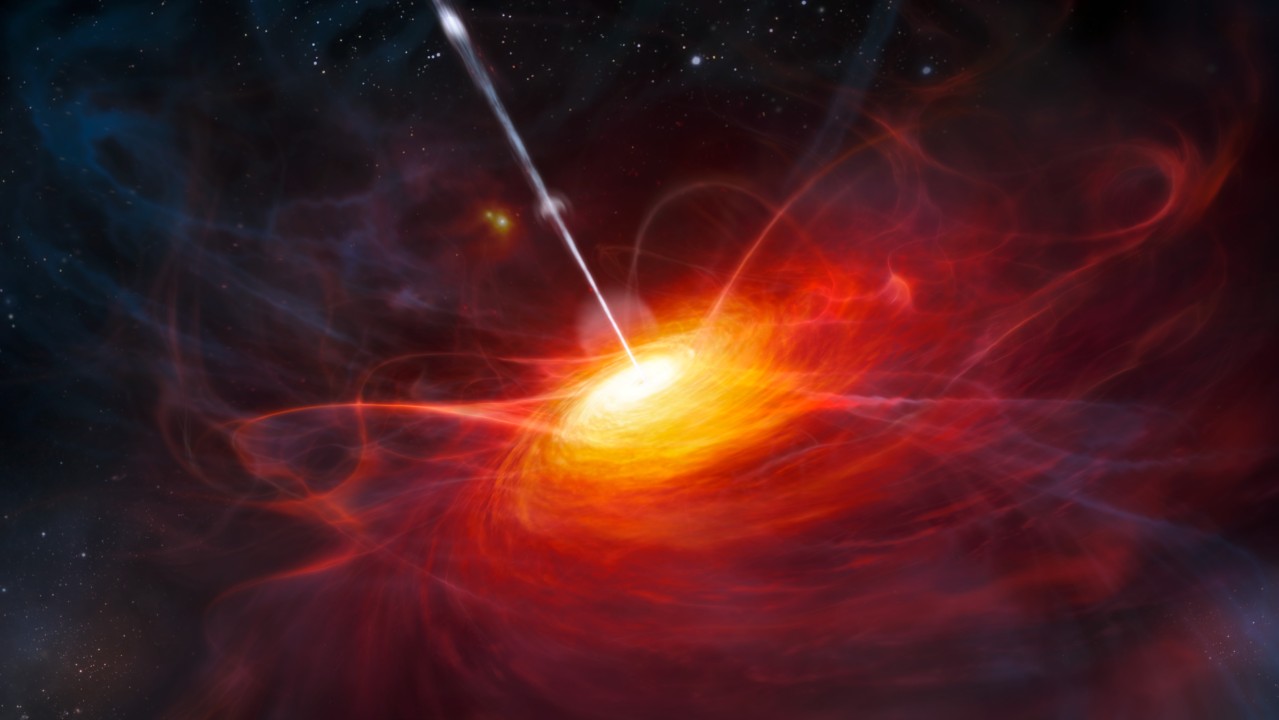Weirdly wobbly jets may be evidence of elusive supermassive black hole pairings
Jets blasting out from feeding supermassive black holes at the heart of active galaxies or blazars suggest these cosmic monsters have company.

Jets blasted out by feeding supermassive black holes at the hearts of active galaxies could brighten and curve due to a "wobble" caused by a second orbiting supermassive black hole, a new study reports.
The revelation could help astronomers hunt for supermassive black hole binaries, which, despite their titanic nature, remain proverbial needles in a cosmic haystack.
Active galactic nuclei (AGNs) powered by feeding supermassive black holes are often so bright they can outshine every star in the galaxy around them combined. When the jets from AGNs are pointed directly at Earth, these events at the heart of galaxies are called "blazars."
Related: Images: Black holes of the universe
These AGNs often flare, briefly brightening. Years of observation of blazar jets show they are not as straight as one might expect, instead often snaking and curving. These two phenomena have been associated with large amounts of material from the accretion disk of gas and dust surrounding the black hole suddenly making its way to the core and either being ejected by the jet or fed to the black hole.
New findings suggest this may be too simple an explanation, instead positing that bent jets and brightening of AGNs could be caused by something making the jet "wobble" or precess. This wobble could be the work of a second black hole lurking in the hearts of blazar galaxies, the new study suggests. Alternatively, the swirling jet could be caused by a warp in the accretion disk around a solo supermassive black hole.
"We present evidence and discuss the possibility that it is, in fact, the precession of the jet source, either caused by a supermassive binary black hole at the footpoint of the jet or — less likely — by a warped accretion disk around a single black hole, that is responsible for the observed variability," study leader Silke Britzen, a researcher at the Max Planck Institute for Radio Astronomy in Bonn, Germany, said in a statement.
Get the Space.com Newsletter
Breaking space news, the latest updates on rocket launches, skywatching events and more!

Is two company for supermassive black hole blazars?
The jets from blazars, the team suggests, would be forced to wander as a result of the gravitational influence of the second supermassive black hole as it orbits the AGN's main feeding supermassive black hole.
"The physics of accretion disks and jets is rather complex, but their bulk kinematics (a branch of mechanics concerned with the motion of objects without considering the forces behind that motion) can be compared to simple gyroscopes," study co-author Michal Zajaček, of Masaryk University in the Czech Republic, said in the same statement. "If you exert an external torque on an accretion disk, for instance, by an orbiting secondary black hole, it will precess and nutate, and along with it the jet will as well."
Something similar happens with Earth’s rotation axis, which is affected by the moon and the sun, Zajaček added.
The swirl of jets from AGNs would naturally lead to periodic changes in their brightness, something that has been observed over many years for a number of these black hole-powered events already.
In 2018, the team applied their model of brightness variation and jet-bending to OJ 287, an AGN located 5 billion light-years from Earth that is a candidate to host binary supermassive black holes.
Now, the scientists have applied the model to 12 more bright AGNs. They found that jet curvature and AGN brightening could indeed trace to a second black hole causing a wobble in the jet.
The team can't fully rule out factors in jet physics, such as shock waves or instabilities in the jet, or even magnetic fields, as the driving force behind the curved jets. However, they argue, the jets in question wouldn't be quite as curvy or as bright if it weren't for their wobble.
In addition, the researchers were able to detect additional signs of precession, albeit smaller in amplitude, in radio light coming from the jets, which they think is second-order proof of their model.
The team's work could ultimately give astronomers a better way of searching the universe for supermassive black hole binaries at the hearts of galaxies.
"We still lack the sufficient resolution to probe the existence of supermassive binary black holes directly," Britzen concluded. "But jet precession seems to provide the best signature of these objects, whose existence is expected not only by the black hole/AGN community but also from the gravitational wave/pulsar community, who recently published evidence for the existence of a cosmic gravitational background due to the gravitational waves emitted by the mergers of massive black holes through cosmic history."
The study was published in July in The Astrophysical Journal.
Join our Space Forums to keep talking space on the latest missions, night sky and more! And if you have a news tip, correction or comment, let us know at: community@space.com.

Robert Lea is a science journalist in the U.K. whose articles have been published in Physics World, New Scientist, Astronomy Magazine, All About Space, Newsweek and ZME Science. He also writes about science communication for Elsevier and the European Journal of Physics. Rob holds a bachelor of science degree in physics and astronomy from the U.K.’s Open University. Follow him on Twitter @sciencef1rst.
-
Harmonograms Messier 106 is the poster child for wobbly jets, especially in the Spitzer Space Telescope's infrared images. It appears that at least 2 SMBHs have active jets:Reply









